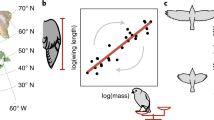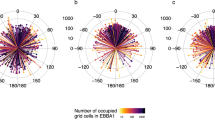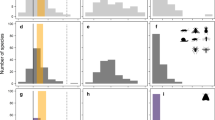Abstract
Identifying the factors that influence range sizes of species provides important insight into the distribution of biodiversity1, and is crucial for predicting shifts in species ranges in response to climate change2,3,4. Current climate (for example, climate variability and climate extremes)5,6, long-term climate change4, evolutionary age2, topographic heterogeneity, land area3,7 and species traits such as physiological thermal limits8, dispersal ability9, annual fecundity and body size3,10 have been shown to influence range size. Yet, few studies have examined the generality of each of these factors among different taxa, or have simultaneously evaluated the strength of relationships between range size and these factors at a global scale. We quantify contributions of these factors to range sizes of terrestrial vertebrates (mammals, birds and reptiles) at a global scale. We found that large-ranged species experience greater monthly extremes of maximum or minimum temperature within their ranges, or occur in areas with higher long-term climate velocity and lower topographic heterogeneity or lower precipitation seasonality. Flight ability, body mass and continent width are important only for particular taxa. Our results highlight the importance of climate and topographic context in driving range size variation. The results suggest that small-range species may be vulnerable to climate change and should be the focus of conservation efforts.
This is a preview of subscription content, access via your institution
Access options
Subscribe to this journal
Receive 12 print issues and online access
$209.00 per year
only $17.42 per issue
Buy this article
- Purchase on Springer Link
- Instant access to full article PDF
Prices may be subject to local taxes which are calculated during checkout


Similar content being viewed by others
References
Jetz, W. & Rahbek, C. Geographic range size and determinants of avian species richness. Science 297, 1548–1551 (2002).
Gaston, K. J. Geographic range limits: achieving synthesis. Proc. R. Soc. B 276, 1395–1406 (2009).
Brown, J. H., Stevens, G. C. & Kaufman, D. M. The geographic range: size, shape, boundaries, and internal structure. Annu. Rev. Ecol. Syst. 27, 597–623 (1996).
Sandel, B. et al. The influence of late quaternary climate-change velocity on species endemism. Science 334, 660–664 (2011).
Janzen, D. H. Why mountain passes are higher in the tropics. Am. Nat. 101, 233–249 (1967).
Pither, J. Climate tolerance and interspecific variation in geographic range size. Proc. R. Soc. Lond. B 270, 475–481 (2003).
Hawkins, B. A. & Felizola Diniz-Filho, J. A. Beyond Rapoport’s rule: evaluating range size patterns of New World birds in a two-dimensional framework. Glob. Ecol. Biogeograph. 15, 461–469 (2006).
Calosi, P., Bilton, D. T., Spicer, J. I., Votier, S. C. & Atfield, A. What determines a species’ geographical range? Thermal biology and latitudinal range size relationships in European diving beetles (Coleoptera: Dytiscidae). J. Anim. Ecol. 79, 194–204 (2010).
Lester, S. E., Ruttenberg, B. I., Gaines, S. D. & Kinlan, B. P. The relationship between dispersal ability and geographic range size. Ecol. Lett. 10, 745–758 (2007).
Laube, I. et al. Towards a more mechanistic understanding of traits and range sizes. Glob. Ecol. Biogeograph. 22, 233–241 (2013).
Sunday, J. M., Bates, A. E. & Dulvy, N. K. Global analysis of thermal tolerance and latitude in ectotherms. Proc. R. Soc. B 278, 1823–1830 (2011).
Araújo, M. B. et al. Heat freezes niche evolution. Ecol. Lett. 16, 1206–1219 (2013).
Khaliq, I., Hof, C., Prinzinger, R., Böhning-Gaese, K. & Pfenninger, M. Global variation in thermal tolerances and vulnerability of endotherms to climate change. Proc. R. Soc. B 281, 20141097 (2014).
Burnham, K. P. & Anderson, D. R. Model Selection and Multi-Model Inference: A Practical Information-Theoretic Approach (Springer, 2002).
Morin, X. & Lechowicz, M. J. Niche breadth and range area in North American trees. Ecography 36, 300–312 (2013).
Bozinovic, F., Calosi, P. & Spicer, J. I. Physiological correlates of geographic range in animals. Annu. Rev. Ecol. Evol. Syst. 42, 155–179 (2011).
Arribas, P. et al. Dispersal ability rather than ecological tolerance drives differences in range size between lentic and lotic water beetles (Coleoptera: Hydrophilidae). J. Biogeogr. 39, 984–994 (2012).
Sunday, J. M. et al. Thermal-safety margins and the necessity of thermoregulatory behavior across latitude and elevation. Proc. Natl Acad. Sci. USA 111, 5610–5615 (2014).
Kronfeld-Schor, N. & Dayan, T. Thermal ecology, environments, communities, and global change: energy intake and expenditure in endotherms. Annu. Rev. Ecol. Evol. Syst. 44, 461–480 (2013).
Sunday, J. M., Bates, A. E. & Dulvy, N. K. Thermal tolerance and the global redistribution of animals. Nature Clim. Change 2, 686–690 (2012).
Whitton, F. J. S., Purvis, A. & Orme, C. D. L. Olalla-Tarraga MA. Understanding global patterns in amphibian geographic range size: does Rapoport rule? Glob. Ecol. Biogeogr. 21, 179–190 (2012).
Bonebrake, T. C. & Mastrandrea, M. D. Tolerance adaptation and precipitation changes complicate latitudinal patterns of climate change impacts. Proc. Natl Acad. Sci. USA 107, 12581–12586 (2010).
Morueta-Holme, N. et al. Habitat area and climate stability determine geographical variation in plant species range sizes. Ecol. Lett. 16, 1446–1454 (2013).
Luiz, O. J. et al. Adult and larval traits as determinants of geographic range size among tropical reef fishes. Proc. Natl Acad. Sci. USA 110, 16498–16502 (2013).
Bird Species Distribution Maps of the World Version 2.0 (BirdLife International and NatureServe, 2012).
Olson, D. M. et al. Terrestrial ecoregions of the world: a new map of life on earth. Bioscience 51, 933–938 (2001).
Blois, J. L., Williams, J. W., Fitzpatrick, M. C., Jackson, S. T. & Ferrier, S. Space can substitute for time in predicting climate-change effects on biodiversity. Proc. Natl Acad. Sci. USA 110, 9374–9379 (2013).
Norman, G. R. & Streiner, D. L. Biostatistics: The Bare Essentials (B. C. Decker, 2007).
Hijmans, R. J., Cameron, S. E., Parra, J. L., Jones, P. G. & Jarvis, A. Very high resolution interpolated climate surfaces for global land areas. Int. J. Climatol. 25, 1965–1978 (2005).
Loarie, S. R. et al. The velocity of climate change. Nature 462, 1052–1055 (2009).
Garrard, G. E., McCarthy, M. A., Vesk, P. A., Radford, J. Q. & Bennett, A. F. A predictive model of avian natal dispersal distance provides prior information for investigating response to landscape change. J. Anim. Ecol. 81, 14–23 (2012).
Liu, X. et al. Congener diversity, topographic heterogeneity and human-assisted dispersal predict spread rates of alien herpetofauna at a global scale. Ecol. Lett. 17, 821–829 (2014).
Baselga, A., Lobo, J. M., Svenning, J. C. & Araujo, M. B. Global patterns in the shape of species geographical ranges reveal range determinants. J. Biogeogr. 39, 760–771 (2012).
Pagel, M. Inferring the historical patterns of biological evolution. Nature 401, 877–884 (1999).
Fritz, S. A., Bininda-Emonds, O. R. P. & Purvis, A. Geographical variation in predictors of mammalian extinction risk: big is bad, but only in the tropics. Ecol. Lett. 12, 538–549 (2009).
Jetz, W., Thomas, G. H., Joy, J. B., Hartmann, K. & Mooers, A. O. The global diversity of birds in space and time. Nature 491, 444–448 (2012).
Freckleton, R. P. On the misuse of residuals in ecology: regression of residuals vs. multiple regression. J. Anim. Ecol. 71, 542–545 (2002).
Jetz, W. & Rahbek, C. Geometric constraints explain much of the species richness pattern in African birds. Proc. Natl Acad. Sci. USA 98, 5661–5666 (2001).
R Core Team R: A Language and Environment for Statistical Computing (R Foundation for Statistical Computing, 2014).
Orme, D. et al. Caper: Comparative Analyses of Phylogenetics and Evolution in R R package version 0.5.2 (R Foundation for Statistical Computing, 2013).
Bartoń, K. MuMIn: Multi-Model Inference R package version 1.10.0 (R Foundation for Statistical Computing, 2014).
Acknowledgements
We thank S. Meiri and F. Xu for providing data on life-history traits of some species and K. Bartoń for the suggestion about multimodel inference with package MuMIn in R. Funding was provided by the National Science Foundation of China (31530088 and 31200416) and the Ministry of Science and Technology of China (2013FY110300).
Author information
Authors and Affiliations
Contributions
Y.L. and X.Li designed the study; X.Li, D.B., Z.L., X.Liu and S.Y. collected the data; Y.L., B.S. and X.Li developed the method for controlling for sampling effect in climate extremes; X.Li, Y.L. and B.S. analysed the data; Y.L., X.Li and B.S. wrote the manuscript.
Corresponding author
Ethics declarations
Competing interests
The authors declare no competing financial interests.
Rights and permissions
About this article
Cite this article
Li, Y., Li, X., Sandel, B. et al. Climate and topography explain range sizes of terrestrial vertebrates. Nature Clim Change 6, 498–502 (2016). https://doi.org/10.1038/nclimate2895
Received:
Accepted:
Published:
Issue Date:
DOI: https://doi.org/10.1038/nclimate2895
This article is cited by
-
Modeling responses of Brazilian Atlantic Forest mammals assemble to climate change
Biodiversity and Conservation (2024)
-
Global topographic uplift has elevated speciation in mammals and birds over the last 3 million years
Nature Ecology & Evolution (2021)
-
Species versus within-species niches: a multi-modelling approach to assess range size of a spring-dwelling amphibian
Scientific Reports (2021)
-
The value of the species interaction-abiotic stress hypothesis (SIASH) for invasion biology: using native latitude to explain non-native latitudinal range sizes
Biological Invasions (2021)
-
Animal invaders threaten protected areas worldwide
Nature Communications (2020)



